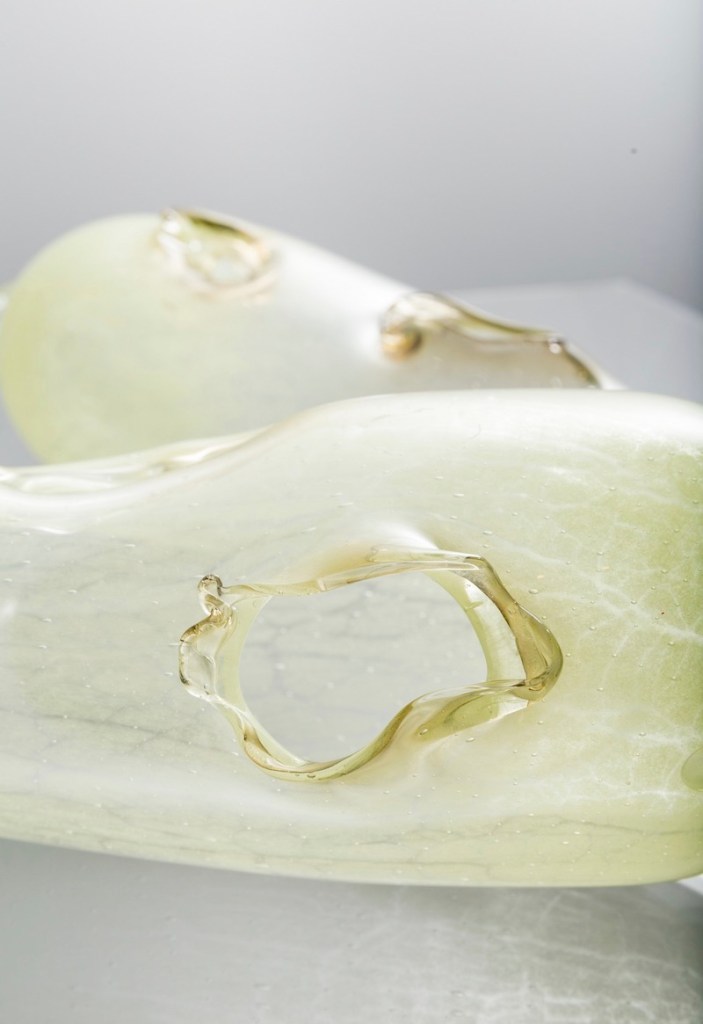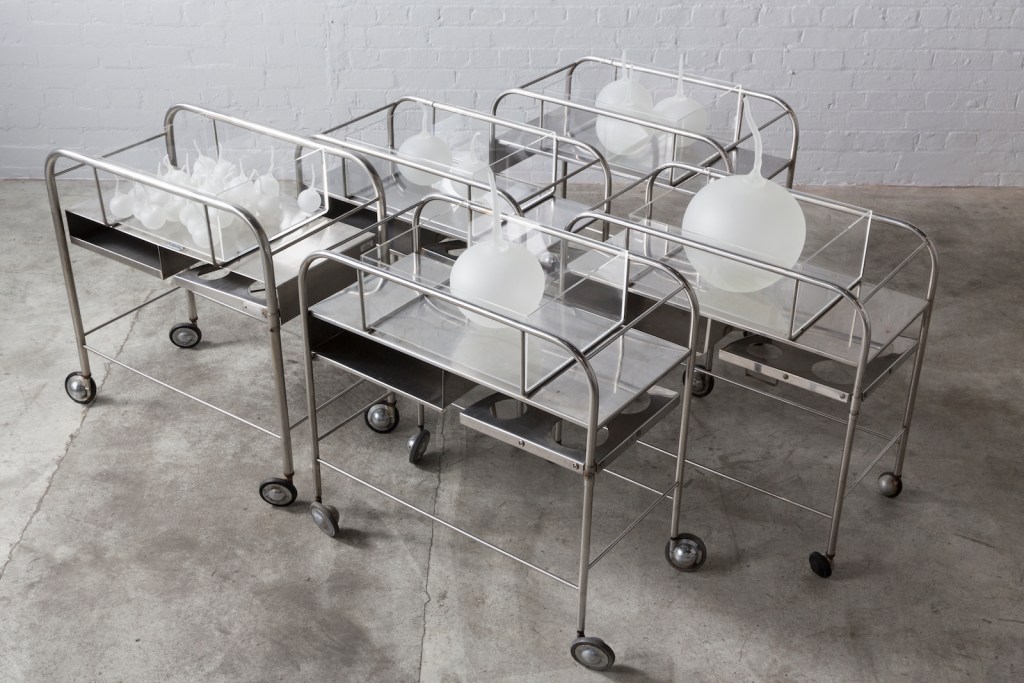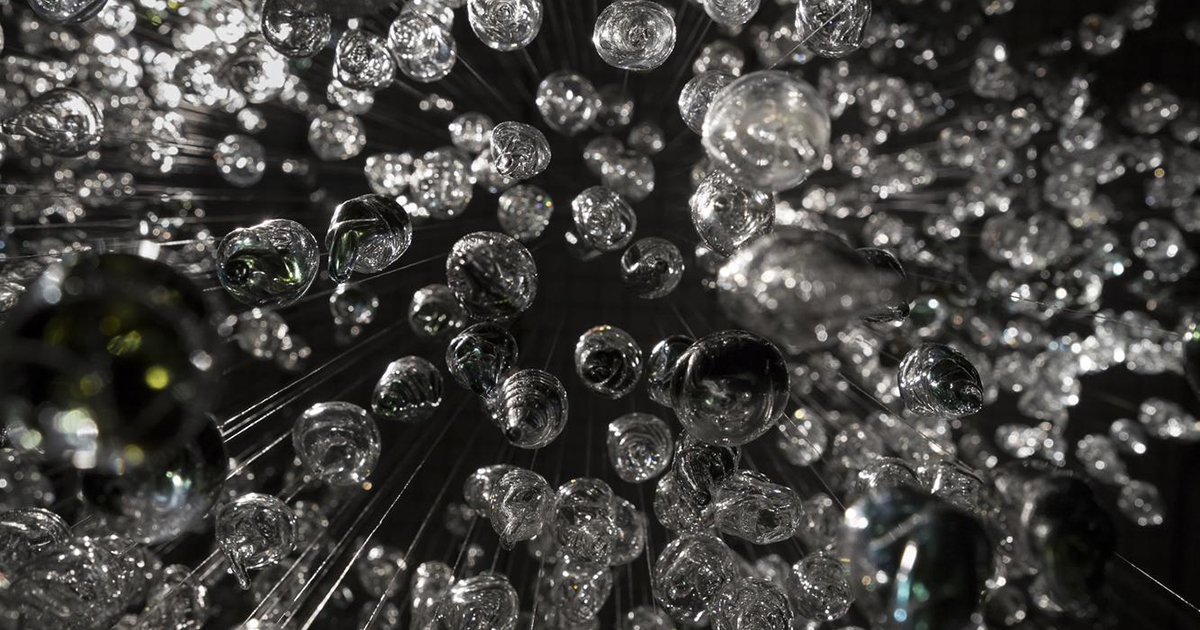Cascading in a shimmer of glass, and soon to sit within a three-storey high void between two levels of the Art Gallery of Western Australia (AGWA), Thunder Raining Poison (2015) is a monumental installation by First Nations Kokatha and Nukunu artist Yhonnie Scarce.
Comprising over 2000 handblown glass yams in a cloud-like formation, the installation is at once stunningly beautiful, and disquieting in its narrative of nuclear testing on Country, at Maralinga in South Australia on Scarce’s ancestral lands. It promises to be a highlight of the 2024 Perth Festival visual arts program, and a cornerstone piece in a new survey exhibition on Scarce’s work curated by Clothilde Bullen, Head of Indigenous Programs at AGWA.
Bullen tells ArtsHub: ‘Professionally, it’s go hard or go home for Perth Festival, and so we did something quite dramatic. We really wanted it to be pretty extraordinary, and Yhonnie’s work allows for those big moments and big conversations for viewers.
‘The Festival theme next year is ‘Ngaangk’, which is the Nyoongar word for the sun. But it also means light – presence – and this show really fits that thematic. The title aptly speaks to unearthing the things we don’t know or haven’t wanted to know – to bring stories into the light of day,’ Bullen continues.
Scarce is arguably one of Australia’s most important contemporary artists, interested in truth-telling and ushering new conversations around histories and memories. Her work is very layered, from large-scale architectural installations to delicate glass artworks, and intimate – and sometimes harrowing – installations that play with repetition in the simplest ways to tell the most complex stories.
‘What I’ve tried to do is loan pretty much every artwork that is around the country, including all of her major installations – like Thunder Raining Poison (2015) and its partner pieces Death Zephyr (2016) and Cloud Chamber (2020), which will be seen together for the first time – as well as works from private collections and her important work Remember Royalty (2018) now in the Tate Collection in London,’ Bullen says of the exhibition, which is titled Yhonnie Scarce: The Light of Day.
‘Installation-wise it’s the most complex exhibition I’ve had to curate in my entire career, this is a whole other level,’ she adds.
Keeping the tough stories accessible
As a curator, Bullen describes her process as deeply collaborative. ‘For me, it’s about working closely to facilitate an artist’s vision. This is a show that Yhonnie and I have wanted to do for a long time – it was the right fit. Also, much of the work is predicated on the impact of mining, in particular uranium mining, so to talk about that in Western Australia is really critical. There’s a whole narrative, particularly from First Nations people, around mining that needs to be heard.’

AGWA is no stranger to presenting glass, as a long-time venue for the respected Tom Malone Prize for glass artists. ‘What I really wanted to do, was to build on that lens of Yhonnie as a contemporary Australian glassmaker, but then to bring in those First Nations stories also. So that was a fine line that we wanted to straddle with this exhibition.’
Across this survey Bullen has worked collaboratively with Scarce to create an artist monograph, learning resources for the exhibition, programming around the exhibition concepts and deeply thought-through accessibility options. ‘The way I work is about making everything accessible to everyone – that absolutely underpins my curatorial practice,’ Bullen explains to ArtsHub.
‘It adds to people being able to understand it in a way that makes sense to them. So humanising it, I guess, especially in a post-referendum moment,’ she adds of the exhibition experience. ‘And I can support the artists’ agency – to interpret the work in the way they need it interpreted and spoken about. And I think you can do that, offer that entry point, when the work is so beautiful.’
Walking into this exhibition that sense of agency will be almost palpable. There is a real physicality to Scarce’s work through its scale and its shimmer. Glass has fragility and yet a strength. It is beautiful, transparent and luminous.
‘There’s a buy-in immediately from a viewer – the work is really pleasing to the eye, and it’s really monumental and very Instagrammable,’ says Bulleen. ‘But I have worked closely with Yhonnie to support access in different ways, including within the exhibition space, and to get down to the nitty-gritty stuff – the dark side to these beautiful works. One can see the beauty and be challenged by the narrative also – the light and shade.’

Scarce is an artist who, for more than three decades, has backed her making with rigorous research and fieldwork. She has also been willing to push the traditional boundaries of materials, using glass in innovative ways or embracing photography as an expanded medium, printing on linen and wool blankets, for example. She has a capacity to blend the scientific with the human, the clinical with the heartfelt.
The survey exhibition, which will open in February, ‘will be really monumental and I think people will see the span of the works collectively and go, “Oh! We didn’t realise all she has actually done.” It will be incredible and a lasting memory,’ concludes Bullen.
Yhonnie Scarce: The Light of Day is presented by The Art Gallery of Western Australia as part of 2024 Perth Festival program. It is open from 2 February through to 19 May 2024, and is a free exhibition.





